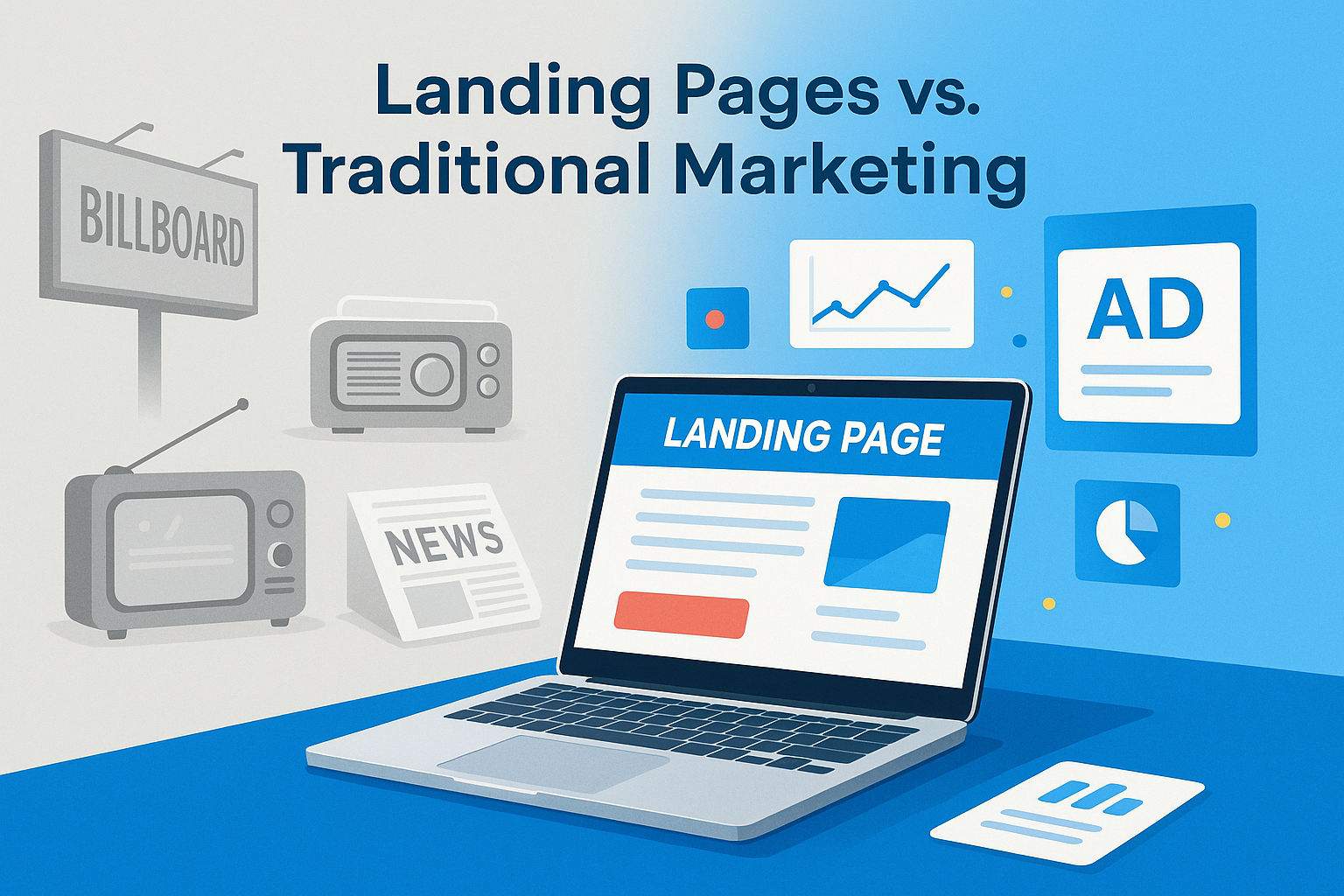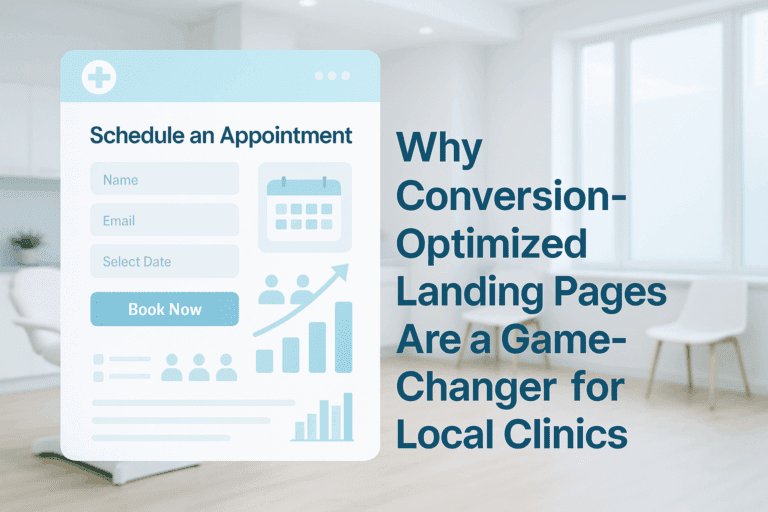Conversion-Optimized Landing Pages vs. Traditional Marketing: Which Wins?
If your marketing strategy feels like shouting into the void, it might be time to rethink where you’re sending your audience.
Fishing with a Rod or a Net?
Picture this: you’re out fishing. Traditional marketing is like casting a massive net into the sea, hoping to catch something — anything. You might reel in a few decent catches, but you’re also dragging in seaweed, old boots, and whatever else happens to be nearby.
Now imagine using a precision fishing rod with the right bait for the exact fish you’re after. That’s what conversion-optimized landing pages offer. They’re focused, data-driven, and built to convert specific visitors into paying customers or qualified leads.
In this article, we’ll explore how these two approaches stack up across six key categories. Whether you’re loyal to old-school methods or looking to modernize, you’ll walk away knowing where your strategy can shine — and where it might be falling flat.
1. Attention Wars: The Battle for Focus in a Noisy World
Let’s face it — people are drowning in content. From inboxes full of unread emails to social feeds that scroll on forever, the fight for attention is real. Traditional marketing, like TV or magazine ads, often ends up lost in the noise.
Landing pages, on the other hand, cut through the clutter. They’re designed with one message, one purpose, and one clear action. No fluff. No distractions.
Practical Tip: Put your main call-to-action front and center, preferably above the fold. Make it impossible to miss.
Stat: Landing pages with a single call-to-action convert over 200% more than those with multiple CTAs (Unbounce).
Quote: “The best marketing doesn’t feel like marketing.” — Tom Fishburne, Marketoonist
2. Targeted vs. Blanket Messaging: Who Really Listens?
Traditional marketing talks to the crowd. Think billboards or radio spots — they’re meant for everyone, which often means they speak to no one in particular.
Landing pages do the opposite. They speak directly to a specific audience segment. Whether it’s dog lovers in Denver or SaaS founders in Singapore, a well-designed landing page can talk to them like a trusted friend who gets it.
Practical Tip: Create separate landing pages for different customer personas or campaigns. Personalization increases relevance, and relevance drives results.
Stat: Personalized CTAs perform over twice as well as generic ones (HubSpot).
Quote: “Don’t find customers for your products. Find products for your customers.” — Seth Godin
3. Measuring What Matters: Data or Gut Feeling?
How do you measure the success of a billboard? Maybe some vague brand awareness? With traditional marketing, the data is murky at best.
Landing pages tell a different story. You can track clicks, scroll depth, bounce rates, conversions — every move your visitor makes. That kind of clarity turns guesswork into strategy.
Practical Tip: Use tools like Google Analytics, Hotjar, or A/B testing platforms to track and improve your landing pages.
Stat: Companies using data-driven marketing are five to eight times more likely to be profitable (Invesp).
Quote: “In God we trust. All others must bring data.” — W. Edwards Deming
4. Speed to Lead: How Fast Are You Converting?
Time is money. Traditional marketing can take months to deliver results, especially when tied to long production cycles or seasonal campaigns.
Landing pages give you instant feedback. You can launch a page in a day, run ads to it the next, and start collecting leads or sales within hours. That kind of speed gives you agility and a serious edge.
Practical Tip: Keep your landing page loading time under three seconds. Use compressed images and clean code to keep things snappy.
Stat: A delay of just one second in page load time can reduce conversions by 7% (Neil Patel).
Quote: “Speed is the currency of business.” — Marc Benioff, CEO of Salesforce
5. Cost Efficiency: Big Budgets vs. Smart Spending
Let’s talk money. A print ad in a national magazine? Thousands of dollars. A TV commercial? Even more. And there’s no guarantee it reaches the right people.
Landing pages are budget-friendly, highly testable, and don’t require a production crew. Even better, you can build multiple versions and test which one works best, all without breaking the bank.
Practical Tip: Use free or low-cost landing page tools like Carrd, Leadpages, or Instapage to get started. No need to hire a full dev team.
Stat: Companies with over 40 landing pages generate 12 times more leads than those with five or fewer (HubSpot).
Quote: “The cost of being wrong is less than the cost of doing nothing.” — Seth Godin
6. Trust & Credibility: Which One Builds It Better?
People are skeptical of ads, especially the old-school kind that makes big promises with little proof. Landing pages provide the space to earn trust with testimonials, reviews, and real-life success stories.
When you add social proof, certifications, or security badges, you help visitors feel confident in clicking that button.
Practical Tip: Place a strong testimonial or customer review near your call-to-action to boost credibility.
Stat: 88% of consumers trust online reviews as much as personal recommendations (BrightLocal).
Quote: “People influence people. Nothing influences people more than a recommendation from a trusted friend.” — Mark Zuckerberg
The Final Verdict: Smart Marketers Mix and Match
Conversion-optimized landing pages win when it comes to targeting, tracking, speed, cost, and results. But that doesn’t mean traditional marketing is obsolete. It still has a place — especially for brand awareness, storytelling, and building a broad presence.
The real winners are the businesses that combine both. They use traditional methods to capture attention and digital strategies to convert it.
Here’s the takeaway: Don’t pick a side. Build a bridge. The smartest marketers create seamless journeys from first impression to final conversion, using the best tools from both worlds.


